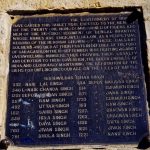VELU THAMPI DALAWA
The Architect of the Travancore Rebellion
In the early years of the 19th Century, after the British succeeded in putting out the fires of the Pazhassi revolt in northern Kerala, the whole of southern Kerala erupted in a fresh rebellion, which took the British by surprise, and posed the biggest challenge to their authority in the region till then, by far. It was led by a man of impeccable background in public service, Velayudhan Chempakaraman Thampi, popularly known as Velu Thampi, the Dalawa (Prime Minister) of Travancore, in alliance with Paliath Achan, his counterpart in Cochin. Velu Thampi had a large following, having led a revolt against bureaucratic misrule, which forced the Raja to yield to the peoples’ demands, before he was appointed the Dalawa. He resented the interference in the state’s administration by the British Resident, Colonel Colin Macaulay, and joined hands with Paliath Achan, who too was facing similar difficulties with the British at Cochin. Together, they raised a force, mostly of Nairs, but joined, as in the case of the Pazhassi revolt, by volunteers from all communities. They then attempted to bring the Marathas and the Poligars of Madurai into a broad-based alliance with them, while also making contact with the French in Mauritius for support.
The rebellion broke out rather extempore at the port city of Cochin on 18 December 1808, when a 600-man force, commanded by Paliath Achan and two of Velu Thampi’s officers, stormed the British Resident’s house. The resident managed to escape by a ship, which arrived at a fortunate moment with reinforcements from Malabar. The rebels struck again on the 28th, when a British ship with some troops put into another port town, Alleppey, further south, wiping out a detachment of more than 30 soldiers, sadly including a medical officer. Meanwhile, 50 miles to the south, at Quilon, the British garrison, comprising three Madras Infantry battalions under Lieutenant Colonel John Chalmers, was getting hemmed in by the Travancore forces advancing on the town from various directions, also using the Ashtamudi Lake bordering the town and other waterways to approach it in boats.
On 11 January 1809, Velu Thampi, who was by now headquartered at Kundara near Quilon, made a proclamation, indicting the British rule and exhorting the people to rally under his banner in his fight against the foreigners. The people’s response was electric. They flocked in thousands to join the ranks of his forces now converging on Quilon. The garrison there, consisting of the 2nd, 4th and 26th Madras Infantry Regiments, had since been reinforced by the 36th MI and a British battalion, the 12th Foot. The British estimated that Velu Thampi had nearly 30,000 men under his colours, with some 18 guns. Chalmers dug in his heels. Velu Thampi unleashed an attack on 15th January, the fiercest the Madras Army faced in the campaign. In a grim battle fought over five hours, the Madras Army bested the Travancore forces decisively. Velu Thampi’s losses were enormous. The debacle broke the back of the rebellion. Nevertheless, four days later the combined forces of Cochin and Travancore, numbering about 3000, launched an attack on Cochin. The defending garrison of the 33rd MI and 50 British soldiers of the 12th Foot, commanded by Major Hewitt, repulsed the attack gallantly, inflicting heavy loss to the attackers. The rebel attacks on the cantonments continued during the month, but proved futile.
In the meantime, to the south, the Madras Army reinforcements, under Lieutenant Colonel St. Leger entered Travancore through the Aramboli Pass, and managed to capture the forts of Udayagiri and Padmanabhapuram by 19th February. Later during the month, following a severe defeat at the British hands, Paliath Achan deserted the alliance. Deported to Madras, he was never permitted to visit Cochin again. The Raja of Travancore, finding St. Leger’s forces assembled at the southern suburbs of his capital, Trivandrum, and Chalmers’s troops on the northern side, sued for peace and ordered the Dalawa’s arrest.
Cornered by the Raja’s men at the Bhagavathy Temple at Mannadi, Velu Thampi, proud and defiant to the end, committed suicide rather than be taken alive. Nevertheless, the vengeful British put his dead body on exhibition, hanging it from a gibbet at Trivandrum. His house was razed to the ground, his relatives were exiled to Maldives and his followers were hanged or banished from the country.
The Travancore State Manual narrates the end of the Dalawa thus: “The fallen Dalava was obliged to move from place to place to avoid the disgrace of surrendering and falling a victim to the vindictiveness of his enemies. At last, he took refuge in a Potti’s house at Mannati on the bank of the Kollakatavu River. The secret was soon out, and Karyakkar Mallan Pillai with a company of Nayars under a Subadar surrounded the place where the Dalava had set up a fugitive abode. The house was soon broken in. Velu Thampi, realizing the magnitude of the danger, resolved to put an end to his existence rather than allow the enemies to capture him alive. He ordered his brother to dispatch him but the latter would never commit fratricide. The Dalava therefore plunged his dagger into his own bosom. Fearing that the self-inflicted wound might prove not fatal, he cried out to his brother to complete the work. This time the brother complied with his request; and with one stroke of the sword, he severed the head from the body.” Unfortunately, the brother, in turn, was taken captive to Quilon and hanged.
The shameless act of desecration of the mortal remains of the Dalawa by the over-zealous British Resident, though supposedly on the orders of the Raja, was later to be condemned by none other than the Governor General, Lord Minto. He observed: “The ends of justice and the purposes of public security were attained by the death of the Dewan; and the prosecution of a vindictive policy when the object of it had ceased to exist, was repugnant to the feelings of common humanity and the principles of a civilized government.”
It would seem that the British snobbery and obsession with royalty, rather than fair judgment, often dictated their attitude in dealing with whom they perceived as rebels. They had no qualms about hanging Yusuf Khan or Kattabomman, and in Velu Thampi’s case, his dead body, all of whom, in their perception, were commoners. In the case of Pazhassi Raja, mercifully, his princely background discouraged them from insulting his mortal remains. It could also have been the case, that excepting for rare instances like that of Pazhassi Raja, they found the princely class far more amenable than the popular leaders. As it turned out, the close association of the British with the moth-eaten royalty of India in later years was to be their undoing, for it would totally alienate them from the very people they intended to rule.
With the rebellion suppressed, both Travancore and Cochin became subsidiary allies of the British by subsequent treaties, and the native forces of both the states were disbanded. Except for a minor insurrection in 1812 by Kurichiyas and Kurumbars in Wayanad, which was easily put down, Velu Thampi’s was the last glimmer of Malayali defiance against British Imperialism. It was also the first mass revolt in India which made the preservation of the sovereignty of a state and the democratic rights of its people the principal cause. Velu Thampi was born a century too early. His kind of political strategy – he was the first Indian leader known to have effectively used his oratorical skills to motivate people – would one day be wholly adopted by the leaders who would eventually win India her freedom. The legacy of Velu Thampi would inspire the people of Kerala in their ideals of liberty down the lanes of history. Appropriately enough, a statue of his, adorns the state’s secretariat complex at Thiruvananthapuram. Ironically, the muddled politics of the state currently holds no promise for the generations to come, as the lofty ideals the great man fought for did.





